
Cabernet Franc, with its distinct characteristics, has a story to tell—one that's full of depth and intrigue. In this Cabernet Franc grape profile, we traverse from the grape's historical roots through how it has carved its niche in the wine world, to exploring the perfect growing conditions that Cabernet Franc cherishes, learning how the elements of nature shape its growth. Our adventure takes us across different wine-producing regions, uncovering how each place leaves its own mark on the grape.
Along the way, we'll uncover fun, lesser-known facts about Cabernet Franc, adding layers of fascination to our narrative. Finally, we'll toast to the grape's versatility, celebrating the diverse and exquisite wines it brings to life, affirming its beloved place in the hearts of wine lovers.
Cabernet Franc, a key but often unsung hero in the wine world, is celebrated for its dynamic nature and intricate flavor profile. This grape, a major black grape variety, is primarily used in the renowned Bordeaux blend with Cabernet Sauvignon and Merlot, and is also esteemed as a single varietal wine, especially in the Loire Valley and as ice wine in North America, especially in Canada and the US (home of Zinfandel grape and wine). This is due to the fact that Cabernet Franc pairs well wiht a wide range of food, thanks to the unique aromatic and flavor profile Cabernet Franc tend to have.
With a lighter body than Cabernet Sauvignon, Cabernet Franc wines have a pale red hue, and stand out for their elegance and spicy bouquet. Its aroma palette ranges from tobacco to raspberry and bell pepper, adding to its allure.
Originating in Bordeaux and a parent to grapes like Cabernet Sauvignon, Merlot, and Carménère, Cabernet Franc is cherished for its early ripening, which suits cooler climates. Its growth habit is robust, favoring soils like sandy and chalk, which influence the wine's body and taste. However, careful yield management is crucial to maintain its distinct flavor profile.
If you want to learn more about Cabernet Sauvignon, Merlot or Grenache wines, check out their comprehensive in-depth profiles.
The story of the Cabernet Franc grape is a tapestry of geographic shifts and evolving tastes. Its roots trace back to the Basque region of Southwest France, gaining early acclaim in the 17th century when introduced to the Loire Valley. In Bordeaux, known as Bouchet or Breton, it initially played a pivotal role in the region's blends.
However, as Cabernet Sauvignon rose to prominence in Bordeaux, Cabernet Franc found a nurturing haven in the cooler Loire Valley. This period also marked its genetic influence, leading to the creation of Sauvignon Blanc and Carménère wines.
The 20th century saw a resurgence of Cabernet Franc in Bordeaux, acknowledging its contribution to the region's blends' elegance and finesse. Its adaptability shone through as it flourished in the diverse climates of the United States.
Today, Cabernet Franc is revered for its unique ability to express terroir, enjoying renewed interest and appreciation worldwide. This enduring journey from regional grape to global favorite underscores its resilience and versatility in the wine world.
Cabernet Franc, renowned for its adaptability and versatility, thrives under specific viticultural conditions that significantly influence its flavor profile and the characteristics of Cabernet Franc wine. This grape variety is celebrated for producing wines with a diverse range of tastes, from tart red fruit flavors in cooler climates to fuller-bodied wines with dried fruit flavors in warmer regions.

These soils are preferred due to their ability to provide the right balance of nutrients and drainage, ensuring optimal grape quality.
The ideal temperature range for the development of Cabernet Franc grapes is between 15°C and 25°C. Below this range, growth and ripening are slow, leading to underdeveloped flavors. On the other hand, above this range, rapid ripening can occur, potentially diminishing the grapes’ complex aroma and taste profile.
The ideal average annual rainfall for the development of Cabernet Franc grapes is between 500 and 750 mm. Low rainfall levels are crucial to prevent water stress and reduce the risk of fungal diseases. On the other hand, overabundance of rainfall can dilute the flavor and compromise the grapes' quality.
A good average value for the adequate development of Cabernet Franc is 3,000 GDD Adequate heat accumulation during the growing season is vital for proper ripening, flower bud formation, and cane maturation. Regions like the Hudson Valley exemplify this need with their specific GDD levels.
The altitude at which Cabernet Franc is grown varies significantly among different wine regions. In the Chinon area of the Loire Valley, France, Cabernet Franc is grown at an altitude of around 60 meters above sea level. On the other hand, in Tuscany, Cabernet Franc is cultivated at higher elevations, around 500 meters above sea level. Finally, in the Napa Valley, Cabernet Franc is found at even higher altitudes, with vineyards like the Stagecoach Vineyard situated at elevations over 366 meters.
These variations in altitude contribute to the distinct characteristics of Cabernet Franc wines from each region, as altitude can significantly influence factors like temperature, sunlight exposure, and microclimates.
Cabernet Franc plays a pivotal role in the global wine industry. Originating in France, this grape has found its way into diverse regions around the world, each offering a unique expression of the varietal. The character of Cabernet Franc is profoundly influenced by the terroir - a term that encapsulates the environmental factors like soil, climate, and topography. This interaction between the grape and its terroir results in wines that are not only reflective of their geographical origin but also exhibit a wide range of flavors and aromas.

Cabernet Franc is a grape variety celebrated for its versatility and unique expressions in different regions of the world. Renowned for its contribution to the complexity and aroma of wines, Cabernet Franc brands stand out for their distinctive flavor profiles and significant influence in the wine world. Here, we delve into some of the most famous Cabernet Franc brands, highlighting their aroma, flavor characteristics, and why they are particularly esteemed among wine connoisseurs.
These brands exemplify the diverse expressions of Cabernet Franc across different wine-producing regions. From the structured elegance of Bordeaux to the vibrant and earthy tones of the Loire Valley, and the lush, fruit-driven character of Californian wines, Cabernet Franc continues to make a significant mark in the world of fine wines. Each brand not only offers a unique taste experience but also reflects the cultural and geographical nuances of its region, making Cabernet Franc a fascinating study for wine enthusiasts.
Cabernet Franc, a grape with a rich history and unique characteristics, has firmly established itself as a cornerstone in the world of viticulture. Originating in France and now cultivated in diverse terroirs globally, it offers a fascinating array of flavors and styles. Fun facts, like its genetic link to Cabernet Sauvignon and Merlot, add to its intrigue.
Its resilience in various viticultural conditions, from the cool climates of the Loire Valley to the sun-kissed hills of California, demonstrates its versatility. The regions where Cabernet Franc thrives each impart distinct characteristics, influencing the grape's profile from earthy and herbaceous to rich and fruity.
The grape's impact extends beyond its own varietal wines; it plays a crucial role in blends, contributing depth, complexity, and aroma. Renowned wines like Château Cheval Blanc in Bordeaux and Tua Rita Redigaffi in Tuscany highlight its global appeal and adaptability. Each bottle of Cabernet Franc tells a story of its origin, a testament to the grape's ability to capture and reflect the essence of its terroir.
In sum, Cabernet Franc is not just a grape variety; it's a narrative of history, geography, and the art of winemaking. Its journey from ancient vineyards to modern glasses encapsulates a legacy that continues to evolve, enchant, and educate wine lovers around the world.
If you want to learn about different aspects about Cabernet Sauvignon wines, such as how to pair Cabernet Franc wine, which flavour profile Cabernet Franc tends to have or which are the simmilarities and differences between Cabernet Franc and Pinot Noir wines, then you can check our in-depth guide about Cabernet Franc wines! On the other hand, if you have a wine brand and want to stand out in the wine market, then our article about How to Develop a Wine Brand that Stands of the Crowd have insights that can help you to reach your goal.





























































































.webp)

.webp)





Are you interested in
collaborating with us?